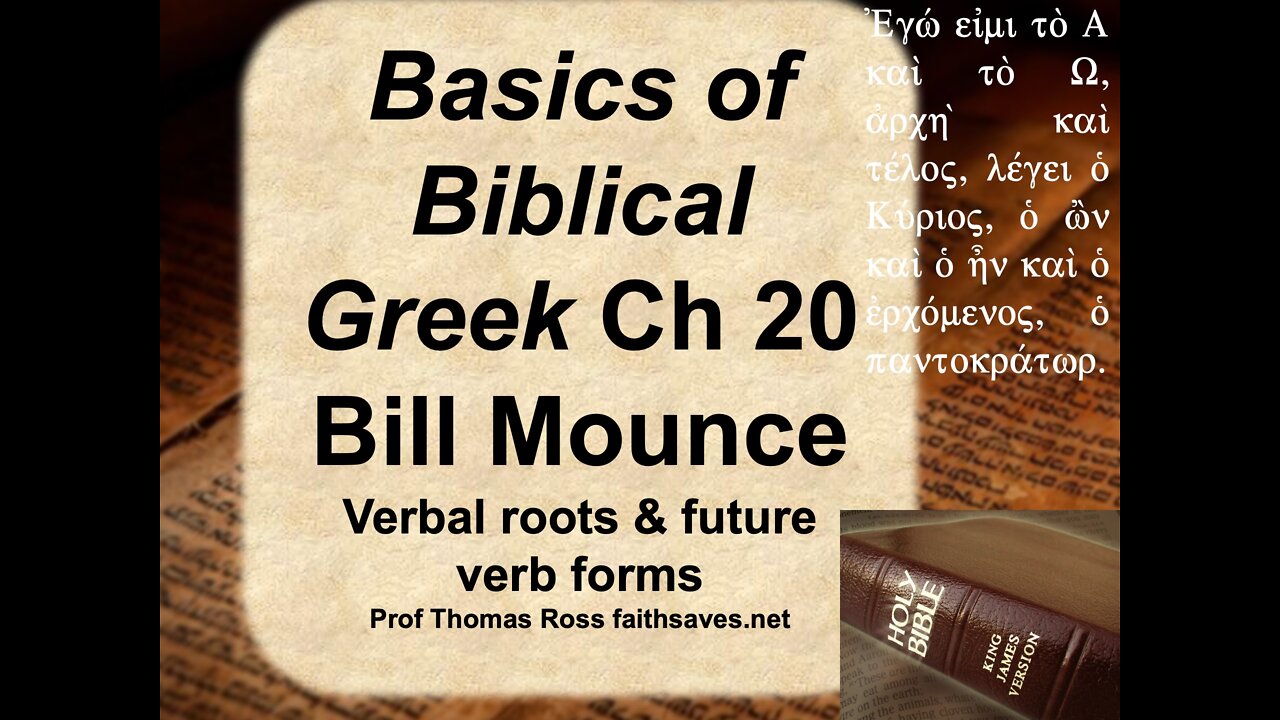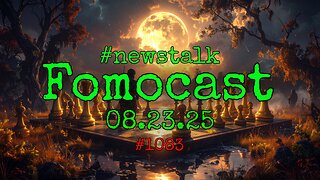Premium Only Content

New Testament Greek #22: Verbal Roots & Other Future Forms, Basics of Biblical Greek Chap 20, Mounce
Lecture #22 in New Testament or Koine Greek, covers chapter 20 of William (Bill) Mounce’s Basics of Biblical Greek textbook, along with Conversational Koine phrases in T. Michael W. Halcomb, Speak Koine Greek: A Conversational Phrasebook.
After the exegetical insight examining the Deity of Christ in Hebrews 1, chapter 20 of Mounce's first year Koine Greek textbook covers:
the difference between the verbal “root” of a verb, which is its most basic form, and the “stem” of the verb as it appears in a certain tense;
that sometimes the verbal root is the same as the present tense stem, and other times it is modified in the formation of the present tense;
that tense stems are not formed from the present tense stem but from the root;
liquid futures.
While a root is the most basic form of a word, which is marked in the lexicon and through BBG with an asterisk, a stem is the most basic form of a verb in a particular tense. Think of the root in connection with the word, but of the stem in connection with a tense.
How do the roots and stems relate to one another? There are four patterns that specify how the root is related to the present tense stem. In pattern #1, the present tense stem is identical to the root. Pattern one has three sub-patterns: stems ending in iota or upsilon, contract verbs, and roots ending in a stop. Patterns #2-4, however, are a little harder, because the roots that fit into these patterns are roots that were modified in the formation of the present tense stem. It is crucial to remember that all stems are formed from the root. They are not formed from the present tense stem!
Students must learn:
1.) The difference between a root and a stem. The root is the most basic form of a word, while a stem is the most basic form of a verb in a particular tense.
2.) All the tense stems are formed from the root, not formed from the present tense stem.
3.) The present tense is the most irregular; do not base your conclusions on the present tense stem.
4.) You simply must memorize the root. If you learn the lexical form and the root of a verb then the rest of the verbal system is surprisingly straightforward.
In pattern #2 totally different roots being used in the formation of the different tense stems. So these are the verbs that are the most different in their different stems, and you will simply need to memorize the different stems.
Pattern #3 is called “the liquid futures." What is a liquid? A liquid is a stem that ends in λ, μ, ν, or ρ. These consonants are called “liquids” because the air flows around the tongue (λ, ρ) or the sound goes through the nose (μ, ν) when pronouncing the letter. (Technically, only lambda and rho are liquids. Mu and nu are called “nasals.” But because liquids and nasals often behave in the same manner, they are usually grouped together under the one heading of “liquid.”) The sentence “Y’aλλ μust νow ρ!” may help you remember the liquid consonants.
Liquids have a different tense formative in the future. The liquid future tense formative εσ, and contraction often takes place. To keep liquid future actives distinct from epsilon-contract present tense verbs, consider the lexical form of the verb and the presence or absence of a liquid consonant before the contracted syllable.
The liquid future middle contains no surprises. The tense formative is still εσ, the intervocalic σ drops out, and so the expected contractions take place.
In summary, pattern 3 verbs (liquid verbs) end in a liquid (λ, μ, ν, ρ) and they use εσ as the future tense formative. The sigma drops out before the connecting vowel, and the vowels contract, looking as if the verb were a present tense epsilon contract. Sometimes the stem vowel changes in the future.
Pattern #4 contains verbs that modify the root in the formation of the present tense stem, including verbal roots ending in a stop (ιζω, αζω, σσω), stems ending in a double consonant, and roots that add one or more letter(s) (ισκ). The second sub-pattern consists of words that in the present tense stem have double consonants (excluding –ασσω verbs which are in pattern #1).
Some verbs may be deponent in one tense but not in another. Also, a compound verb is one where a preposition and a simple verb are put together. For example, ἐκ means “out,” βάλλω means “I throw,” and ἐκβάλλω means “I throw out.” In the formation of the future of compound verbs, the verbal part changes in the same way that the simple, non-compounded form does.
In the chapter vocabulary, βαπτίζω means “immerse” or “dip.” The μα suffix is often used in Greek to specify the result of the action described by the root. The result of being immersed (βαπτίζω) is that one has received baptism (βάπτισμα). Even in Mark 7:4-5 baptidzo has its normal meaning; the “tables” or dining couches of the passage were indeed immersed by the Jews. Also, there is no conspiracy against immersion in the fact that the KJV translators transliterated the verb instead of rendering it "to immerse."
-
 2:40:21
2:40:21
BlackDiamondGunsandGear
11 hours agoAre ALL Striker Fired Pistols UNSAFE? // After Hours Armory
56.8K16 -
 LIVE
LIVE
TheSchleppy
6 hours ago✨TheSchleppy✨EWC COUNTER STRIKE 2 GRAND FINAL *MONGOLZ v AURORA*
52 watching -
 6:34:50
6:34:50
SpartakusLIVE
15 hours ago#1 Saturday Spartoons on RUMBLE PREMIUM
131K7 -
 1:04:59
1:04:59
Man in America
16 hours ago“Summoning the Demon” — The AI Agenda Is FAR WORSE Than We Know w/ Kay Rubacek
67K49 -
 2:16:48
2:16:48
Tundra Tactical
14 hours ago $0.15 earned🎯💥 The World’s Okayest Gun Show 🔫😂 | LIVE Tonight on Rumble!
49.2K1 -
 3:36:03
3:36:03
Mally_Mouse
1 day ago🌶️ 🥵Spicy BITE Saturday!! 🥵🌶️- Let's Play: Tower Unite!
70.2K3 -
 58:59
58:59
MattMorseTV
14 hours ago $1.82 earned🔴Trump just BROKE Newsom.🔴
94.7K104 -
 18:14
18:14
Her Patriot Voice
14 hours agoWho Is WORSE for NYC: Trump Girl or Socialist?
69.7K36 -
 3:39:42
3:39:42
SavageJayGatsby
13 hours agoSpicy Saturday with Mally! | Road to 100 | $300 Weekly Goal for Spicy Bites!
60.9K1 -
 3:35:50
3:35:50
FomoTV
15 hours ago🚨 Swamp Theater: FBI Raids Bolton 🕵 Still NO Epstein Files, Trump's Troops & the Red Heifer Hoax 🐂 | Fomocast 08.23.25
29.7K7